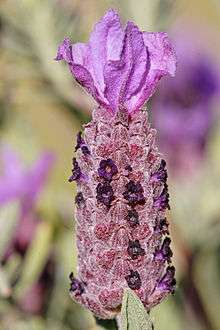Lavandula stoechas
Lavandula stoechas, the Spanish lavender or topped lavender (U.S.) or French lavender (U.K.),[1] is a species of flowering plant in the family Lamiaceae, occurring natively in several Mediterranean countries, including France, Spain, Portugal, Italy and Greece.[2]
| Lavandula stoechas | |
|---|---|
 | |
| Lavandula stoechas flowers | |
| Scientific classification | |
| Kingdom: | Plantae |
| Clade: | Tracheophytes |
| Clade: | Angiosperms |
| Clade: | Eudicots |
| Clade: | Asterids |
| Order: | Lamiales |
| Family: | Lamiaceae |
| Genus: | Lavandula |
| Species: | L. stoechas |
| Binomial name | |
| Lavandula stoechas | |
Description
It is an evergreen shrub that usually grows to between 30 and 100 cm tall and occasionally up to 2 m (6.5ft) tall in the subspecies L. stoechas subsp. luisieri. Its leaves are 1–4 cm long, greyish and tomentose. The inflorescence is crowned by a mass of purple elongated ovoid bracts about 5 cm long. Lower flowers form a tight rectangular in cross-section. The upper of the five teeth has a wrong-heart-shaped appendage. The crown is blackish-violet, up to 8 mm long and indistinct two-lipped.
The flowers, which appear in late spring and early summer, are pink to purple, produced on spikes 2 cm long at the top of slender, leafless stems 10–30 cm (4–12 in) long; each flower is subtended by a bract 4–8 mm long. At the top of the spike are a number of much larger, sterile bracts (no flowers between them), 10–50 mm long and bright lavender purple (rarely white). It blooms in spring and early summer, from the month of March in its native habitat, depending on the climate in which it grows.[3]
The Latin specific epithet stoechas comes from the Greek stoichas meaning “in rows”. It is also the Greek name for this species.[4]
Subspecies
The recognised subspecies are:
- L. stoechas pedunculata, the common type specific plant, once taxonomically considered L. pedunculata. There is considerable variation in this subspecies, and it may be split into a number of distinct forms. It is native to many coastal regions of the Mediterranean, with some populations on the Atlantic coasts of Morocco and Spain.[3]
- L. stoechas luisieri, which has petals much less interconnected. It is found mainly in Portugal and adjacent regions of Spain.[3]
Cultivation
This species is more tender than common lavender (Lavandula angustifolia), being less frost-resistant, but harsher and more resinous in its oils. Like other lavenders, it is associated with hot, dry, sunny conditions in alkaline soils. However, it tolerates a range of situations, though it may be short-lived. Hardy down to −10 °C (14 °F)[1] (USDA zones 6–10).
Selected forms are grown as ornamental plants.[3] The cultivars 'Ballerina'[5] and 'Willow Vale'[6] have gained the Royal Horticultural Society's Award of Garden Merit.[7]
Other uses
Lavandula stoechas is used commercially in air fresheners and insecticides. Flower spikes have been used internally for headaches, irritability, feverish colds and nausea, and externally for wounds, rheumatic pain and as an insect repellent. The lavender also produces essential oils, but is not used commercially for this purpose. The infusion of its dry inflorescences are febrifuge and fight the affections of the chest and bronchi. It is used as antiseptic, digestive, antispasmodic, healing and antibacterial. The flowers are used in aromatherapy, to prepare infusions and essential oils that contain ketones (d-camphor and d-fenchone) and alcohols (borneol and terpineol).[8]
Invasive species
Since its introduction into Australia, it has become an invasive species, widely distributed within the continent. It has been declared a noxious weed in Victoria since 1920. It also is regarded as a weed in parts of Spain.[9]
Gallery
- Wild L. stoechas
- Wild in Ceuta, Spain
- Subspecies pedunculata
- Subspecies luisieri
 Italy
Italy
References
- RHS A-Z encyclopedia of garden plants. United Kingdom: Dorling Kindersley. 2008. p. 1136. ISBN 1405332964.
- Dankwart Seidel: Flowers on the Mediterranean. Determine without fail with the 3-check . BLV, Munich 2002, ISBN 3-405-16294-7
- Upson and Andrews; The Genus Lavandula
- Harrison, Lorraine (2012). RHS Latin for Gardeners. United Kingdom: Mitchell Beazley. ISBN 184533731X.
- "Lavandula 'Ballerina'". RHS. Retrieved 19 March 2020.
- "RHS Plant Selector - Lavandula 'Willow Vale'". Retrieved 23 February 2020.
- "AGM Plants - Ornamental" (PDF). Royal Horticultural Society. July 2017. p. 59. Retrieved 19 March 2018.
- Bown, Deni (2002). The Royal Horticultural Society Encyclopedia of Herbs and Their Uses (Revised ed.). DK. p. 257. ISBN 1-4053-0059-0.
- Csurches S., Edwards R.; National Weeds Program, Potential Environmental Weeds in Australia, Candidate Species for Preventative Control; Queensland Department of Natural Resources. January 1998 ISBN 0-642-21409-3
| Wikimedia Commons has media related to Lavandula stoechas. |